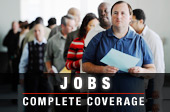Employers stepped up hiring in October and the jobless rate ticked higher as more workers restarted job hunts, a hopeful sign for a lackluster economy that has been a drag on President Barack Obama’s reelection chances.

Employers added 171,000 people to their payrolls last month, the Labor Department said on Friday. The government also said 84,000 more jobs were created in August and September than initially estimated.
The jobless rate edged a tenth of a point higher to 7.9 percent, but that was due to a surge of workers back into the workforce. Only people who have recently looked for a job count as unemployed. "These are positive numbers," said Fabian Eliasson, vice president of currency sales at Mizuho Corporate Bank in New York.
The employment data was the last major report card on the economy before Tuesday’s presidential election, which pits Obama against Republican Mitt Romney. While the rise in the jobless rate was expected, the increase in payrolls beat even the most optimistic forecast in a Reuters poll. U.S. stock index futures jumped following the data while prices for U.S. government debt fell.
The report provides fodder for both candidates. Even sustained monthly gains of 171,000 would likely bring down the jobless rate only slowly. A full recovery from the 2007-09 recession remains distant. The jobless rate, which peaked during the recession at 10 percent, remains about 3 percentage points above its pre-recession level. Romney has made the nation’s feeble jobs market, which has plagued Obama since he took office in 2009, the centerpiece of his campaign.
The latest Reuters/Ipsos daily tracking poll showed Obama and Romney in a dead heat. Still, the political impact of the report will likely be muted as most voters’ perceptions on the economy are likely firmly fixed by now. The persistently high unemployment rate makes it unlikely the Federal Reserve will lose its resolve to keep easy money policies in place until the economy shows more vigor.
FISCAL CLIFF
The unemployment rate rose largely because 578,000 people entered the workforce. That helped push the participation rate, a measure of the portion of the population in the labor force, up two tenths of a point to 63.8 percent. The increase in the jobless rate only partially reverses September’s big drop in the unemployment rate.
RELATED: Fiscal Cliff: Two Candidates, Two Approaches
All of the gain in payrolls was in the private sector, which added 184,000 jobs in October, the biggest increase since February. The government shed 13,000 positions. Private service providing jobs were up 163,000, with retail trade adding 36,400 jobs. Temporary help services, often a harbinger of future full-time hiring, added 13,600 jobs, more than reversing the previous month’s decline.
The construction sector saw a 17,000 increase in jobs, the largest rise since January. Still, even with the current pace of job creation, the U.S. economy faces a real threat of a renewed recession next year. Without action by lawmakers, existing legislation will raise taxes and cut spending to the tune of about $600 billion in 2013. That scenario — known in Washington as the "fiscal cliff" — could easily cause the economy to contract.
Europe’s debt crisis, which has hit factories around the world, including those in the United States, is also weighing on the U.S. economic recovery. In October, however, U.S. manufacturer added 13,000 jobs, snapping two straight months of decline.
Nonetheless, the Fed is expected to expand a new bond-buying program at the end of the year to compensate for the end of another stimulus program aimed at driving down borrowing costs. Persistently weak labor market conditions led the central bank in September to launch a program to buy $40 billion worth of mortgage-backed securities every month until there is a sustained pick-up in the labor market.
In October, average hourly earnings fell one cent to $23.58, while the workweek was steady at 34.4 hours.
"We’re way short of where we need to be to bring down the unemployment rate to where the Fed would like to see," said Kathy Jones, a fixed-income strategist at Charles Schwab in New York.
(Additional reporting by Luciana Lopez in New York)




